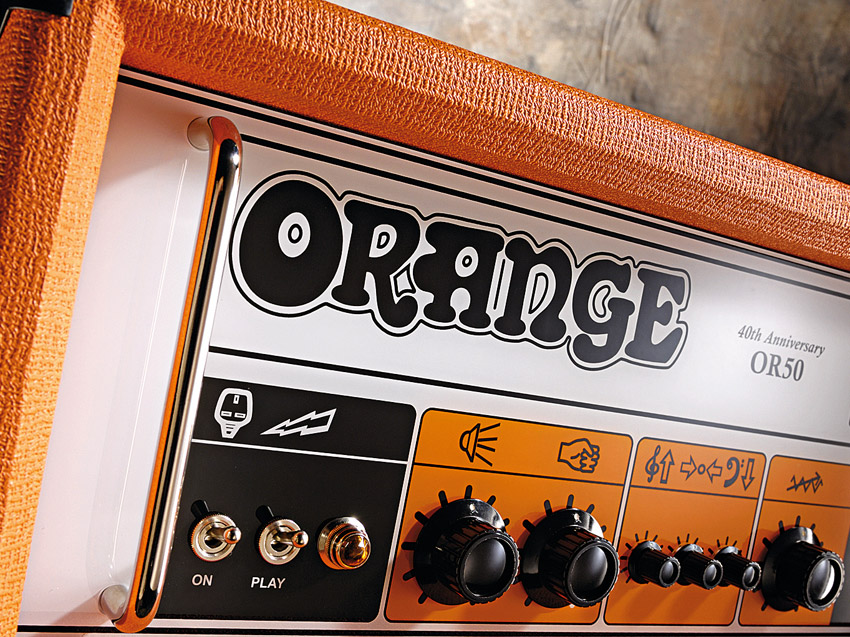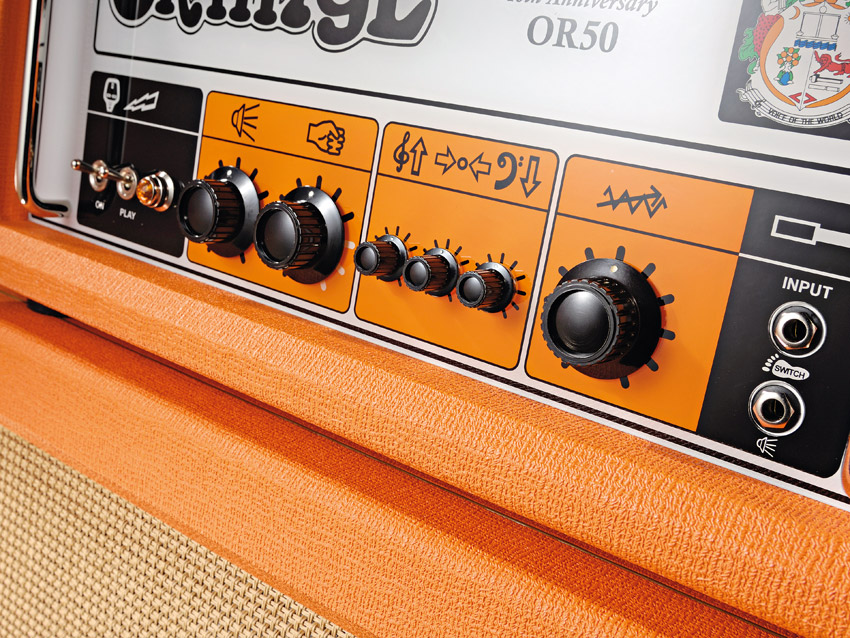MusicRadar Verdict
No-nonsense, single-channel simplicity for rock and blues.
Pros
- +
Looks. Versatility. Straight-up spirited rock tone.
Cons
- -
50-watt power stage compresses too much for conventional metal tones.
MusicRadar's got your back

Orange OR50H

Orange OR50H
This amp is not a reissue; it takes inspiration from 1972's 80-watt Graphic Valve Amplifier - in designer Adrian Emsley's opinion, the time that Orange really found its "glam crunch" sound.
The OR50H uses a new circuit, which claims a slightly more realistic 50 watts from its dual EL34 output valves. It also adds a gain stage and includes the intriguing HF Drive knob.
The HF Drive knob controls presence and gain in the power section. Turning it fully clockwise makes the sound brighter, more lively and with maximum attack. Emsley says: "Up to around eight, it's a cross-line presence on the power amp only, between eight and 10, it adds negative feedback as well to really make it scream."
One feature that's not immediately obvious is the switchable master volume. You can switch the master completely out of the circuit, and control everything from the gain knob. We recommend you take care when you do this for the first time - we had a bit of a Back To The Future/Marty McFly moment!
"A Telecaster bridge pickup returns a raunchy rhythm sound that'll suit biting blues, The Stones, Springsteen and beyond."
In terms of build, the OR50H comes in Orange's standard, high quality ply cabinet, but uses a Plexiglass front panel rather than steel which, along with the more bulbous Orange logo, adds extra retro flavour to the visual package.
Inside it's built to a good standard: the circuitry, pots and preamp valves are on a single, main PCB that's secured to the chassis with bolts. Transformers (wound in the UK), power valve sockets and switches are chassis mounted and are hard-wired, while the jacks have little PCBs of their own.
Sounds
Hear Guitarist's Simon Bradley put the OR50H through its paces in the following clip:
Is a single-channel amp too tonally limited for you? Try this: plug into the OR50H's 'Hi' input, set everything straight up at 12 o'clock and experiment with the gain control.
Using vintage-style humbuckers, below half is where your clean-ish to light crunch tones are. Any classic guitar's natural character is served well, thanks to the focused mid-range and plentiful bottom end.
A Telecaster bridge pickup, for example, returns a raunchy rhythm sound that'll suit biting blues, The Stones, Springsteen and beyond. With a Les Paul, it's Peter Green territory at lower levels, and classic British rock just below half. It does seventies glam-type sounds particularly well, but goes way, way beyond…
Just past 12 o'clock on the gain control brings another gain stage that, when using PAF-style humbuckers, offers heavier crunch tones and heads into a fuzzier distortion.
This will be enough drive for most blues and classic rockers; rounder and slightly more compressed than you'd get from a 50-watt Marshall JCM800. It retains a fair helping of bite though, so we're not talking super-smooth Mesa-style gain.
After around two o'clock on the gain control, in comes the third stage, which takes you into metal levels of distortion if you so desire - certainly not a feature of the 1972 amp! It's a thick, rich drive with tons of bottom end though, with the 50-watt power stage, metal isn't perhaps best served.
Combined with the relatively low power G12H 70th Anniversary speakers in the matching PPC412 LTD cabinet (£699), the power amp lacks the headroom of a 100-watter, instead saturating and compressing slightly for a more elastic feel.
The HF Drive control is intriguing. For want of a better tonal description, imagine you have a series of thin cotton sheets held a few feet away from the speakers. Turning the HF Drive control clockwise feels to us like removing the sheets, one by one, until you're hearing - at about two or three o'clock - the clearest representation of the sound.
"It retains a fair helping of bite, so we're not talking super-smooth Mesa-style gain."
Turned past that point you get an enhanced version of the tone, with extra punch, presence and more visceral power. Lower settings are good for darker tones, but we like the HF Drive more at the higher settings: it feels alive, edgy and super responsive to the dynamics in your playing. We should also note that it can prove to be extremely revealing in terms of string noise and sloppy technique.
The defeatable master volume switch helps expand your dynamic options too. With a gig-level master volume setting of between 11 and two o'clock before you switch, it provides a great headroom/volume boost which you can use to either get your solos heard more clearly, or conversely, to enable you to roll the guitar's volume back to clean things up: unconventional but nonetheless useful.
If you're the kind of player who doesn't need reverb, effects loops and channel switching - you just want a half-stack to plug in and rock with, perhaps on the end of your pedalboard - then the OR50H comes highly recommended.
It's very well built and covers a broad range of rock tones that you wouldn't think possible from a single channel. These 50 watts are more than enough for medium-sized gigs, and although it has a respectable set of clean sounds, it's crunch and medium gain Brit-rock where it really shines. Nice work once again, Orange Amplifiers.
“Built from the same sacred stash of NOS silicon transistors and germanium diodes, giving it the soul – and snarl – of the original”: An octave-fuzz cult classic returns as Jam Pedals resurrects the Octaurus
What’s the buzz? Meet Yellowjacket, Cherry Audio's recreation of EDP’s trend-setting Wasp from 1978
“A fabulous trip through all eight songs by 24 wonderful artists and remixers... way beyond anything I could have hoped for”: Robert Smith announces new Cure remix album









